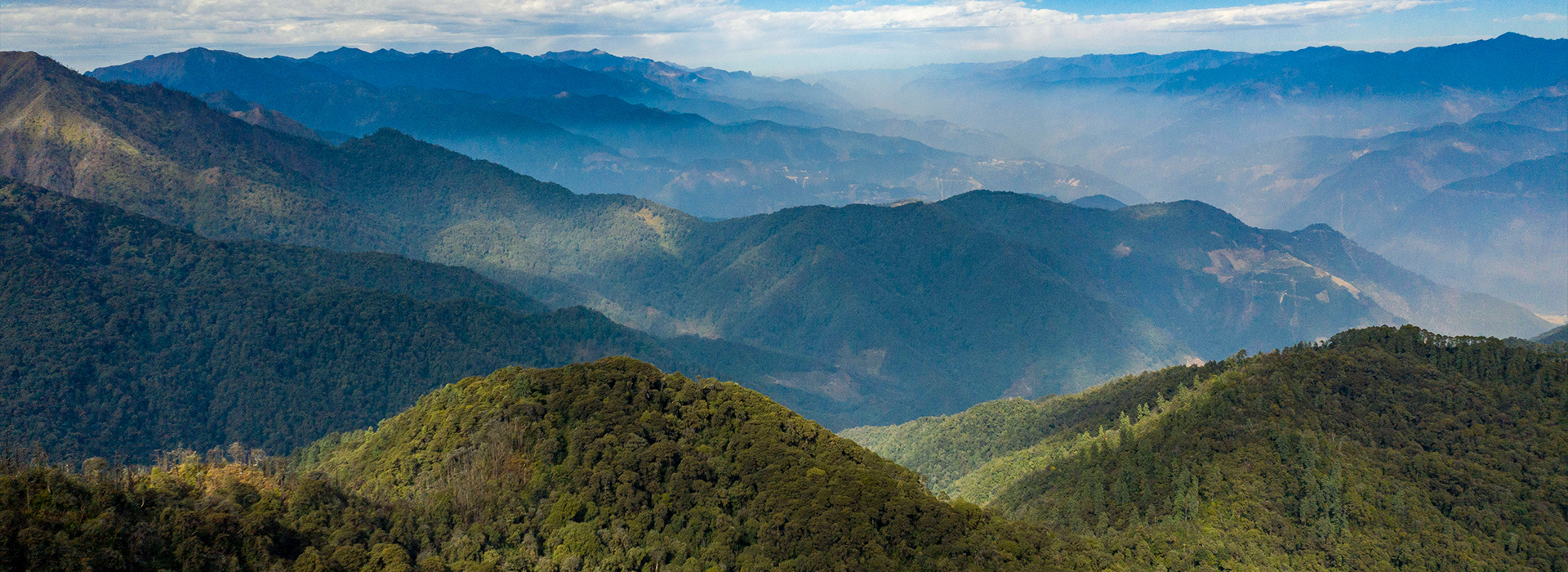Cultural origins
The Baima Snow Mountain National Nature Reserve is located south of the Yunnan Golden Monkey National Park, bordering the Baima Snow Mountain Nature Reserve. The Baima Snow Mountain National Nature Reserve is situated in Deqin and Weixi counties, Diqing Tibetan Autonomous Prefecture, northwestern Yunnan Province, geographically located between 27°24′—28°35′ north latitude and 98°55′—99°24′ east longitude. It is a wildlife-type nature reserve with a total area of 281,640 hectares. Located in the Hengduan Mountains of western China, the Baima Snow Mountain National Nature Reserve is one of the world's most biodiverse regions, a hotspot for biodiversity conservation and ecological construction, a crucial habitat for the Yunnan snub-nosed monkey (a rare and endangered species and a national Class I protected animal), a core area of the "Three Parallel Rivers" World Natural Heritage Site, and a beautiful landmark of Shangri-La. The reserve's topography is extremely complex, differing significantly from other regions; the terrain slopes from north to south, situated at the transition zone between the Qinghai-Tibet Plateau and the Yunnan-Guizhou Plateau. The reserve boasts rich natural geographical environments and biological resources, exhibiting a striking transitional character. The Baima Snow Mountain Nature Reserve is China's largest national nature reserve for Yunnan snub-nosed monkeys. Its primary protection targets are high-altitude coniferous forests, the vertical zonation of mountain vegetation, and the Yunnan snub-nosed monkey.
The Baima Snow Mountain National Nature Reserve is one of China's best-preserved areas of original high-altitude coniferous forests in low-latitude, high-altitude regions, showcasing high biodiversity. The terrain slopes from north to south, running north-south, with a complex geological structure and a deep, high-mountain valley topography. The highest altitude is 5,429 meters, and the lowest is 1,950 meters, with 27 snow-capped peaks exceeding 5,000 meters in altitude. The reserve's unique geographical location and natural conditions result in rich vegetation types, diverse habitats, north-south penetration of flora and fauna, high species diversity, and numerous endemic species. It is one of the 200 global biodiversity hotspots and one of the most biodiverse reserves in China.
The vertical distribution of plants within the reserve is exceptionally clear, forming a spectacular vertical vegetation zonation that can be divided into seven vegetation zones, eleven vegetation subtypes, and 37 communities. From the Jinsha River valley to the main peak of Baima Snow Mountain, the relative altitude difference is 3,479 meters. Vertically distributed vegetation types include valley shrub zones, warm-temperate coniferous forests, temperate coniferous forests, cold-temperate coniferous forests, subalpine shrub meadows, alpine scree sparse vegetation zones, and alpine ice and snow zones.
Preliminary surveys indicate that the reserve contains 1,703 species of seed plants, including 6 families, 15 genera, and 29 species of gymnosperms; and 135 families, 565 genera, and 1,674 species of angiosperms. National Class I protected plants include four species: *Cyrtomium fortunei*, *Kingdonia uniflora*, *Taxus wallichiana*, and *Davidia involucrata*. National Class II protected plants include ten species such as *Tricholoma matsutake*, *Cordyceps sinensis*, *Picea brachytyla*, *Pseudotsuga forrestii*, *Torreya fargesii*, *Tetracentron sinense*, and *Stauntonia chinensis*.
The reserve is home to 98 species of wild mammals belonging to 9 orders, 24 families, and 69 genera; and 237 bird species (plus 9 subspecies) belonging to 16 orders and 42 families. These include 178 resident bird species and subspecies, 32 migratory and wintering bird species and subspecies, and 35 summer and breeding bird species and subspecies. National Class I protected wildlife includes 15 species such as the Yunnan snub-nosed monkey, snow leopard, clouded leopard, clouded leopard, musk deer, alpine musk deer, black stork, golden eagle, and lammergeyer. National Class II protected wildlife includes 36 species such as macaques, pangolins, black bears, brown bears, red pandas, large-spotted civets, golden cats, serows, Himalayan griffon vultures, Tibetan snowcocks, blood pheasants, red-billed tragopans, Tibetan tragopans, and white-bellied pheasants.
The Yunnan snub-nosed monkey is the flagship species of the Baima Snow Mountain Reserve, one of the most human-like creatures globally. With its white face and red lips, and neat, white teeth similar to humans, it is considered one of the most beautiful animals in the world and is a national Class I protected animal. It is only found in a small area of approximately 20,000 square kilometers in the low-latitude, high-altitude region of China, at the junction of Sichuan, Yunnan, and Tibet, in the Yunling Mountains of the southern Himalayas and Hengduan Mountains, between the Lancang and Jinsha Rivers, within well-preserved original high-altitude dark coniferous forests. Currently, there are about 16 populations and 2,000 individuals globally. The Baima Snow Mountain Reserve has about 8 populations and 1,500 individuals, accounting for 70% of the total.
The reserve and surrounding communities involve 13 townships, 48 administrative villages (offices), 14,849 households, and 73,042 people. Within the reserve, there are 5 townships, 13 administrative villages (offices), 1,768 households, and 9,584 people. Residents are primarily Tibetan and Lisu, with other ethnic groups including Naxi, Yi, Bai, Dulong, and Pumi, among more than a dozen. The reserve is located in a multi-ethnic and multi-religious region, characterized by its ancient, magical, and vast nature. The rich, long, and unique cultural resources here are rare globally, a confluence of diverse lifestyles and customs from multiple ethnic groups, languages, scripts, and religious beliefs, with unique styles and diverse interests. A long history of cultural heritage has created countless colorful ethnic literary arts and music and dance.
Over 99% of the local community population practices religion. Tibetan Buddhism is universally practiced by the Tibetan people within the reserve. Tibetan Buddhism advocates against killing and harming living beings and promotes the protection of sacred mountains, lakes, and water source forests. Tibetan Buddhism plays a significant role in biodiversity conservation in this region, particularly with the living Buddha's teachings on the ethics of "harmony between heaven and man" and the reverence for nature, which has positively promoted conservation efforts. The various ethnic groups here have created their unique ecological protection cultures, where humans and nature coexist in the same space, achieving mutual dependence and adaptation. Excellent traditional ethnic cultures play an important role in biodiversity conservation in this area.
In 1983, the Baima Snow Mountain Provincial Nature Reserve was established with the approval of the Yunnan Provincial Government; in 1988, it was upgraded to a national nature reserve; in 2000, it was expanded with the approval of the State Council; in October 2003, with the approval of the prefectural committee, a prefecture-level government-affiliated management bureau was established in Shangri-La, with subordinate management sub-bureaus in Deqin and Weixi, and six management offices in Xiaoruo, Benzilan, Yeri, Tacheng, Kangpu, and Badi, implementing vertical management of personnel in the two sub-bureaus. In 2017, the reserve was renamed the management bureau, with internal organizational structure including four functional departments (offices): the office, resource protection department, science popularization and education department, and foreign exchange and cooperation management office. Two management sub-bureaus were established in Deqin and Weixi, with four management stations under the Deqin sub-bureau and three under the Weixi sub-bureau. Three institutions were established: an ecological research institute, an ecotourism management station, and the Quzonggong ecological positioning monitoring station.
Over 30 years of efforts, the reserve has achieved remarkable results in resource conservation and management, community co-management, science popularization and education, and scientific research and monitoring, which have been fully affirmed by higher authorities. In 2006, our region was identified by the State Forestry Administration as one of the first national demonstration nature reserves; in 2011, it ranked among the top in the province in the national seven-department (committee, bureau) joint assessment of reserve management performance led by the Ministry of Environmental Protection, and was rated as an "excellent" management unit; in 2013, the reserve was awarded the honorary title of "National Advanced Collective" by seven central ministries (committees) including the Ministry of Environmental Protection. From 2014 to 2018, it was recognized as an "excellent" unit for five consecutive years in the comprehensive target supervision and assessment of the state government.
Baima Snow Mountain National Nature Reserve belongs to the cold temperate forest ecosystem type and is a high-altitude coniferous forest area in low-latitude, high-altitude regions of China where biological resources are relatively well-preserved and pristine. According to the division of Chinese vegetation regions, it belongs to the Eastern Himalayas forest flora subregion and Hengduan Mountains region of China, and is one of the areas with the richest alpine plants in the world. The reserve has discovered 142 families, 587 genera, and 1747 species (including subspecies, forms, and varieties) of seed plants. Among them: 6 families, 14 genera, and 29 species of gymnosperms; 136 families, 573 genera, and 1718 species of angiosperms.
There are 24 nationally protected rare plants in the reserve, including: 4 first-class protected plants, 9 second-class protected plants, and 11 third-class protected plants; and 6 provincially protected plants, including: 2 second-class protected plants and 4 third-class protected plants.
The flora of the reserve is rich in families, genera, and species, and it almost includes all woody genera distributed in the temperate zone of the world, such as fir, spruce, pine, maple, birch, oak, and rhododendron. Among them, there are 6 species (including varieties) of fir, including long-bracted fir, acute long-bracted fir, Cangshan fir, Chuandian fir, Yunnan yellow-fruited fir, and Zhongdian fir, all gathered in one reserve, which is truly rare. There are 47 known species of rhododendrons distributed in the reserve, of which 36 are endemic to the Hengduan Mountains, and 15 have their type localities in and around the reserve.
The reserve has 30 nationally and provincially protected plants belonging to 20 families. Among them: 1 species of ferns, 6 species of gymnosperms from 3 families, and 23 species of angiosperms from 16 families. There are 724 species of ornamental plants from 81 families and 223 genera. Among them: 20 species of ferns from 7 families and 11 genera, 28 species of gymnosperms from 5 families and 15 genera, and 568 species of seed plants from 69 families and 154 genera. There are 386 species of medicinal plants from 110 families and 242 genera. Among them: 7 species of fungi from 5 families and 6 genera, 2 species of lichens from 2 families and 2 genera, 2 species of mosses from 2 families and 2 genera, 8 species of ferns from 6 families and 8 genera, and 367 species of seed plants from 95 families and 224 genera. There are also other plant resources closely related to human life, such as oil plants, starch plants, timber trees, spice plants, fiber plants, and tanning plants.




 Wechat Official Account
Wechat Official Account